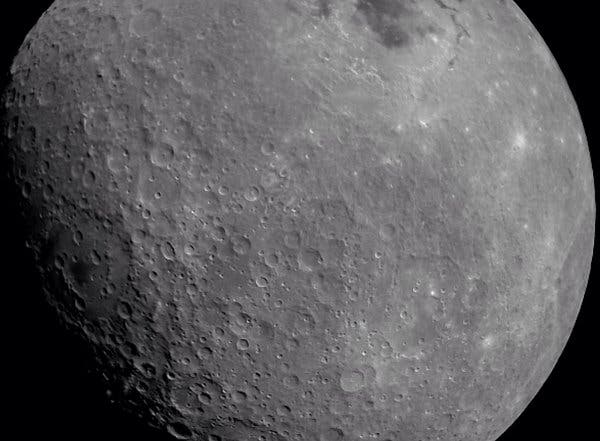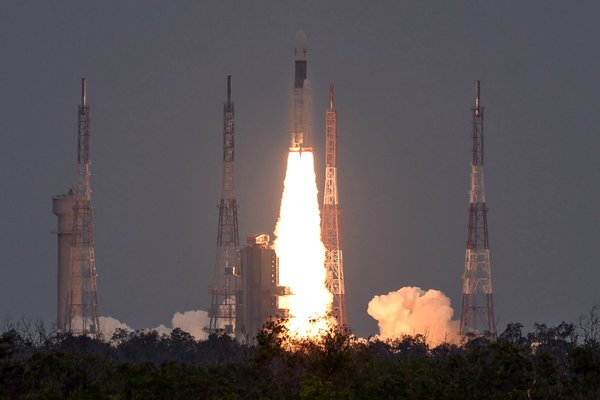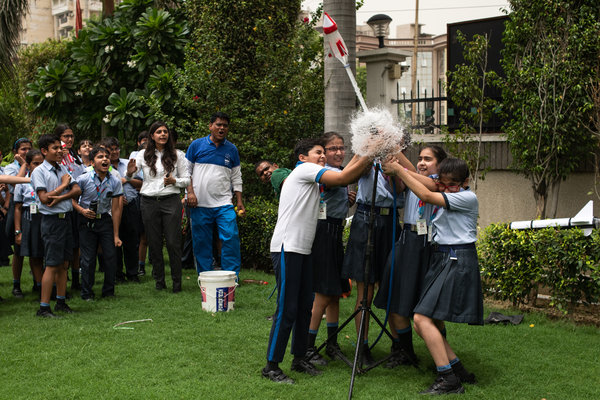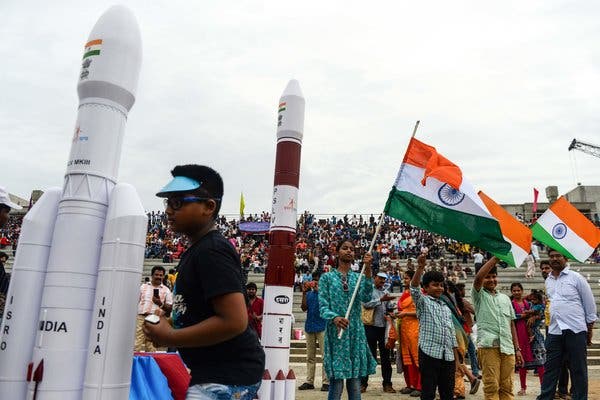BANGALORE, India — India is within reach of the moon.
Weeks after the Chandrayaan-2 mission blasted off, its robotic Vikram lander will attempt a touchdown early on Saturday.
If the mission is successful, India will become only the fourth nation to land on the moon, after the United States, Russia and China. Around the world, scientists are closely watching to see if India can land safely at an unexplored region near the moon’s South Pole.
Riding on the homegrown mission are the hopes of a nation that has increasingly asserted its technological prowess on the world stage.
“There is a huge symbolic value attached to this mission,” said Pallava Bagla, co-author of a book about Indian space exploration and science editor of NDTV, one of India’s TV news channels. “This is all about national pride.”
Space has become a bit of a craze in India. In some Indian cities, Chandrayaan-2 posters have been plastered on giant billboards. Schoolchildren in space classes are launching rockets made from empty plastic bottles.
[Sign up to get reminders for space and astronomy events on your calendar.]
And space has offered India’s government, led by Prime Minister Narendra Modi and his populist Bharatiya Janata Party, a welcome distraction from dismal job numbers, declining economic growth and conflict in Kashmir.
After the Chandrayaan-2 mission launched in July, Mr. Modi released a video of himself watching the launch live, the Indian flag behind him as he stood and clapped.
“Modi is very keen on positioning India as a global power,” said Arati Jerath, a political analyst in New Delhi. “Moon missions are part of creating that image.”

Mr. Modi plans to watch Saturday’s landing at an Indian Space Research Organization facility in an industrial area of Bangalore with several dozen schoolchildren and the nation’s top scientists. Ahead of the prime minister’s arrival, the police set up checkpoints outside and practiced security drills.
The lander — called Vikram, after Vikram A. Sarabhai, the father of the Indian space program — will touch down between 1:30 and 2:30 a.m. with a six-wheeled rover inside. (It will be between 4 and 5 p.m. Friday in New York.)
Chandrayaan-2 was relatively inexpensive compared with other space missions. It cost less than $150 million, cheaper than the budget to make the 2014 Hollywood film “Interstellar.”
The South Pole of the moon is interesting to scientists because of the possibility that water ice could be there. That could be useful for moon habitation and making fuel for exploring Mars. Scientists also want to look for deposits of helium-3, potentially a future energy source for Earth.
The lander and rover are expected to operate for a couple of weeks. They carry instruments that can determine the composition of moon rocks and make other measurements.
The mission launched July 22 after a number of delays. The spacecraft then took a slower, fuel-efficient path to the moon. Through repeated firings of its thrusters, Chandrayaan-2 stretched its elliptical orbit until it was captured by the moon’s gravity.
On Monday, the lander separated from the orbiter, and it has since been completing orbital maneuvers leading up to the hardest part of the mission: a soft landing.
The delay in communicating across far distances — the moon is more than 200,000 miles from Earth — means Indian engineers and scientists will have limited control on Saturday during the landing attempt.
Vivek Singh, a spokesman for ISRO, India’s version of NASA, said scientists were working “around the clock” to ensure as smooth a landing as possible.
Similar missions have ended in disaster. When an Israeli nonprofit tried a similar moon mission called Beresheet in April, the lander crashed. Communications cut out, and people gathered in the control room had tears in their eyes.
The moon mission has been years in the making for ISRO, founded in 1969, when components of rockets were transported by bicycles and assembled by hand.
Since then, India has organized a number of cost-effective robotic missions.
In 2008, Chandrayaan-1 completed some 3,400 orbits around the moon and contributed to confirming the presence of water ice in lunar craters near the poles.
In 2013, India sent a spacecraft to Mars for about $74 million, far less than the $671 million spent by the United States to send a mission the same year that carried a more extensive payload of scientific instruments.
In early 2017, India launched a flock of 104 satellites into space over the course of 18 minutes, setting a record.
The agency has plans for future missions, including robotic probes to study Mars, Venus and the sun, as well as hopes to send the first Indian astronauts to orbit in the next decade.
As anticipation built for Saturday’s landing, Srinidhi K.G., 22, a chemical engineer at Exxon Mobil in Bangalore, said the moon mission sent a message to the world that India was not a country to underestimate.
“This is a big step,” he said. “India is a country to look up to.”
____
Ayesha Venkataraman contributed reporting from Thane, India.
Earlier reporting on India’s moonshot
India Launches Chandrayaan-2 Moon Mission on Second Try

India’s Shooting for the Moon, and the Country Is Pumped








